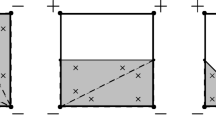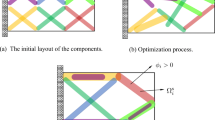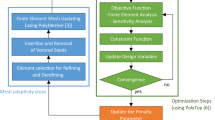Abstract
A multiresolution topology optimization approach is proposed using the p-version finite element method (p-version FEM). Traditional topology optimization, where a density design variable is assigned to each element, is suitable for low-order h-version FEM. However, it cannot take advantage of the higher accuracy of higher-order p-version FEM analysis for generating results with higher resolution. In contrast, the proposed method separates density variables and finite elements so that the resolution of the density field, which defines the structure, can be higher than that of the finite element mesh. Thus, the method can take full advantage of the higher accuracy of p-version FEM.


















Similar content being viewed by others
References
Aage N, Lazarov BS (2013) Parallel framework for topology optimization using the method of moving asymptotes. Struct Multidiscip Optim 47(4):493–505
Aage N, Nobel-Jørgensen M, Andreasen CS, Sigmund O (2013) Interactive topology optimization on hand-held devices. Struct Multidiscip Optim 47(1):1–6
Aage N, Andreassen E, Lazarov BS (2014) Topology optimization using PETSc: an easy-to-use, fully parallel, open source topology optimization framework. Struct Multidiscip Optim 51(3):565–572
Amir O, Bendsøe MP, Sigmund O (2009) Approximate reanalysis in topology optimization. Int J Numer Methods Eng 78(12):1474–1491
Amir O, Stolpe M, Sigmund O (2010) Efficient use of iterative solvers in nested topology optimization. Struct Multidiscip Optim 42(1):55–72
Amir O, Aage N, Lazarov BS (2014) On multigrid-CG for efficient topology optimization. Struct Multidiscip Optim 49(5):815–829
Bendsoe MP, Kikuchi N (1988) Generating optimal topologies in structural design using a homogenization method. Comput Methods Appl Mech Eng 71(2):197–224
Bendsøe MP, Sigmund O (1999) Material interpolation schemes in topology optimization. Arch Appl Mech 69(9):635–654
Borrvall T, Petersson J (2001) Large-scale topology optimization in 3D using parallel computing. Comput Methods Appl Mech Eng 190(46–47):6201–6229
Bruns TE, Tortorelli DA (2001) Topology optimization of non-linear elastic structures and compliant mechanisms. Comput Methods Appl Mech Eng 190(26–27):3443–3459
Challis VJ, Roberts AP, Grotowski JF (2014) High resolution topology optimization using graphics processing units (GPUs). Struct Multidiscip Optim 49(2):315–325
Cook RD, Malkus DS, Plesha ME, Witt RJ (2007) Concepts and Applications of Finite Element Analysis, John Wiley & Sons, New York
Costa JCA Jr, Alves MK (2003) Layout optimization with h-adaptivity of structures. Int J Numer Methods Eng 58(1):83–102
Diaz A, Sigmund O (1995) Checkerboard patterns in layout optimization. Struct Multidiscip Optim 10(1):40–45
Düster A, Bröker H, Rank E (2001) The p-version of the finite element method for three-dimensional curved thin walled structures. Int J Numer Methods Eng 52(7):673–703
Düster A, Parvizian J, Yang Z, Rank E (2008) The finite cell method for three-dimensional problems of solid mechanics. Comput Methods Appl Mech Eng 197(45):3768–3782
Evgrafov A (2014) State space Newton’s method for topology optimization. Comput Methods Appl Mech Eng 278:272–290
Evgrafov A, Rupp CJ, Maute K, Dunn ML (2008) Large-scale parallel topology optimization using a dual-primal substructuring solver. Struct Multidiscip Optim 36(4):329–345
Guest JK, Smith Genut LC (2010) Reducing dimensionality in topology optimization using adaptive design variable fields. Int J Numer Methods Eng 81(8):1019–1045
Guest J, Prévost J, Belytschko T (2004) Achieving minimum length scale in topology optimization using nodal design variables and projection functions. Int J Numer Methods Eng 61(2):238–254
Guo X, Zhang W, Zhong W (2014) Doing topology optimization explicitly and geometrically—a new moving morphable components based framework. J Appl Mech 81(8):081009
Jog CS, Haber RB (1996) Stability of finite element models for distributed-parameter optimization and topology design. Comput Methods Appl Mech Eng 130(3–4):203–226
Kim JE, Jang GW, Kim YY (2003) Adaptive multiscale wavelet-Galerkin analysis for plane elasticity problems and its applications to multiscale topology design optimization. Int J Solids Struct 40(23):6473–6496
Kim TS, Kim JE, Kim YY (2004) Parallelized structural topology optimization for eigenvalue problems. Int J Solids Struct 41(9–10):2623–2641
Le C, Norato J, Bruns T, Ha C, Tortorelli D (2010) Stress-based topology optimization for continua. Struct Multidiscip Optim 41(4):605–620
Le C, Bruns T, Tortorelli D (2011) A gradient-based, parameter-free approach to shape optimization. Comput Methods Appl Mech Eng 200(9):985–996
Matsui K, Terada K (2004) Continuous approximation of material distribution for topology optimization. Int J Numer Methods Eng 59(14):1925–1944
Maute K, Ramm E (1995) Adaptive topology optimization. Struct Multidiscip Optim 10(2):100–112
Mello LAM, De Sturler E, Paulino GH, Silva ECN (2010) Recycling Krylov subspaces for efficient large-scale electrical impedance tomography. Comput Methods Appl Mech Eng 199(49–52):3101–3110
Nguyen TH (2010) System reliability-based design and multiresolution topology optimization. Ph.D thesis, University of Illinois at Urbana-Champaign
Nguyen TH, Paulino GH, Song J, Le CH (2010a) A computational paradigm for multiresolution topology optimization (MTOP). Struct Multidiscip Optim 41(4):525–539
Nguyen TH, Song J, Paulino GH (2010b) Single-loop system reliability-based design optimization using matrix-based system reliability method: theory and applications. J Mech Des 132(1):011005
Nguyen TH, Song J, Paulino GH (2010c) Challenges and advances in system reliability based optimization of structural topology. In: Proceedings of the 19th Analysis and Computation Specialty Conference, ASCE Conf. Proc. doi:10.1061/41131(370)42
Nguyen TH, Song J, Paulino GH (2011) Single-loop system reliability-based topology optimization considering statistical dependence between limit-states. Struct Multidiscip Optim 44(5):593–611
Nguyen TH, Paulino GH, Song J, Le CH (2012) Improving multiresolution topology optimization via multiple discretizations. Int J Numer Methods Eng 92(6):507–530
Nguyen TH, Le CH, Hajjar JF (2013) High-order finite elements for topology optimization. In: 10th world congress on structural and multidisciplinary optimization, Orlando
Norato JA, Bendsøe MP, Haber RB, Tortorelli DA (2007) A topological derivative method for topology optimization. Struct Multidiscip Optim 33(4):375–386
Olhoff N, Bendsøe MP, Rasmussen J (1991) On CAD-integrated structural topology and design optimization. Comput Methods Appl Mech Eng 89(1):259–279
Parvizian J, Düster A, Rank E (2012) Topology optimization using the finite cell method. Optim Eng 13(1):57–78
Rozvany G (1996) Some shortcomings in Michell’s truss theory. Struct Multidiscip Optim 12(4):244–250
Rozvany G (1998) Exact analytical solutions for some popular benchmark problems in topology optimization. Struct Multidiscip Optim 15(1):42–48
Rozvany G, Zhou M, Birker T (1992) Generalized shape optimization without homogenization. Struct Multidiscip Optim 4(3):250–252
Schmidt S, Schulz V (2012) A 2589 line topology optimization code written for the graphics card. Comput Vis Sci 16:249–256
Sigmund O (2000) Topology optimization: a tool for the tailoring of structures and materials. Philos Trans R Soc London, Ser A 358:211–227
Sigmund O (2007) Morphology-based black and white filters for topology optimization. Struct Multidiscip Optim 33(4):401–424
Sigmund O, Petersson J (1998) Numerical instabilities in topology optimization: a survey on procedures dealing with checkerboards, mesh-dependencies and local minima. Struct Multidiscip Optim 16(1):68–75
Stainko R (2006) An adaptive multilevel approach to the minimal compliance problem in topology optimization. Commun Numer Methods Eng 22(2):109–118
Sutradhar A, Paulino GH, Miller MJ, Nguyen TH (2010) Topological optimization for designing patient-specific large craniofacial segmental bone replacements. Proc Natl Acad Sci 107(30):13222–13227
Suzuki K, Kikuchi N (1991) A homogenization method for shape and topology optimization. Comput Methods Appl Mech Eng 93(3):291–318
Svanberg K (1987) The method of moving asymptotes—a new method for structural optimization. Int J Numer Methods Eng 24(2):359–373
Szabo BA, Babuska I (1991) Finite element analysis. Wiley, New York
Szabó B, Düster A, Rank E (eds) (2004) The p-Version of the Finite Element Method vol 1. Encyclopedia of Computational Mechanics
Takezawa A, Kitamura M (2012) Geometrical design of thermoelectric generators based on topology optimization. Int J Numer Methods Eng 90(11):1363–1392
Toogood R, Zecher J (2013) Creo Parametric 2.0 Tutorial. SDC Publications
Vatanabe SL, Paulino GH, Silva ECN (2012) Influence of pattern gradation on the design of piezocomposite energy harvesting devices using topology optimization. Compos Part B 43(6):2646–2654
Wang S, Sturler E, Paulino GH (2007) Large-scale topology optimization using preconditioned Krylov subspace methods with recycling. Int J Numer Methods Eng 69(12):2441–2468
Zhang W, Yuan J, Zhang J, Guo X (2016) A new topology optimization approach based on Moving Morphable Components (MMC) and the ersatz material model. Struct Multidiscip Optim 53(6):1243–1260
Acknowledgements
This research was funded in part by the National Science Foundation under the Grant No. CMMI-1000666 and by Northeastern University. This support is gratefully acknowledged. The second author would like to thank the Vietnam National Foundation for Science and Technology Development (NAFOSTED) for the support under Grant No.107.02-2014.33.
Author information
Authors and Affiliations
Corresponding author
Rights and permissions
About this article
Cite this article
Nguyen, T.H., Le, C.H. & Hajjar, J.F. Topology optimization using the p-version of the finite element method. Struct Multidisc Optim 56, 571–586 (2017). https://doi.org/10.1007/s00158-017-1675-7
Received:
Revised:
Accepted:
Published:
Issue Date:
DOI: https://doi.org/10.1007/s00158-017-1675-7




